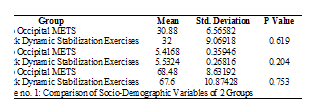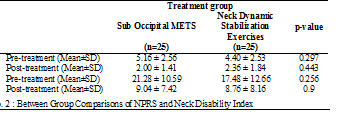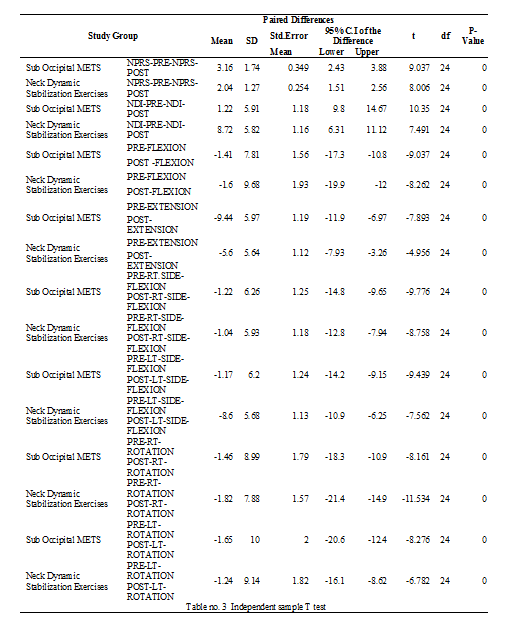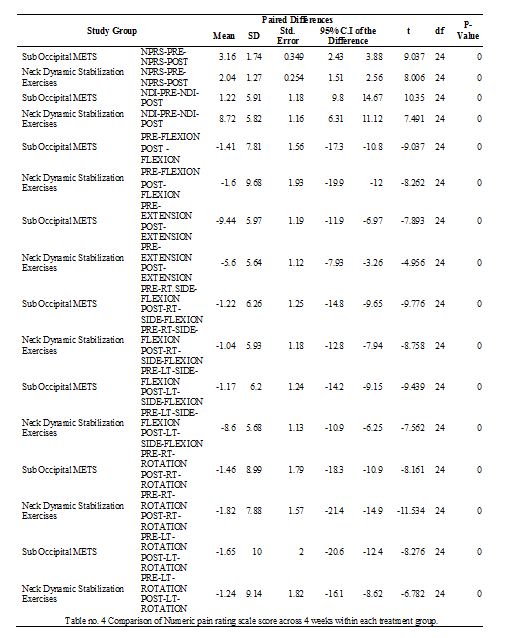Muhammad Qasim Idrees[i], Anam Saleem[ii], Arif Ali Rana[iii]
DOI: 10.36283/pjr.zu.11.2/003
ABSTRACT
Background: Cervical pain is an unpleasant bodily sensory feeling in the cervical regions which manifest as tiredness, stiffness or discomfort that give off to the upper region and shoulders, as well as head. Cervical pain is a very common challenging condition in the whole world as well as two thirds of persons will experience cervical discomfort in their lives
Objective: To compare the effectiveness of Sub Occipital Muscle Energy Techniquees and Dynamic Stabilization exercises in chronic neck pain among IT professionals.
Study design and Sampling technique: Current study was the randomized controlled trial. In which muscle energy technique was compared with dynamic stabilization exercises for neck pin. All patients were equally divided into two groups by using the fishbowl method.
Study Setting & Participants: Data was collected from 50 IT professionals e.g., laptop users, desktop users. Study duration was 04 weeks. The data was calculated by Kannan Rehabilitation Clinic.
Interventions & Data Collection tools: The Neck Disability Index Questionnaire (NDI) was used for each patient, before and after treatment. Group A receives the sub occipital muscle energy techniques and Group B receives the neck dynamic stabilization exercises.
Results: In this study, both groups are effective, but neck dynamic stabilization exercises are more effective than the sub occipital muscle energy techniques.
Conclusion: This study concludes that the neck dynamic stabilization exercises are better as compared to sub occipital muscle energy techniques in the treatment neck pain. Sub occipital muscle energy techniques are also effective, but neck dynamic stabilization exercises are more effective for neck pain and functional mobility.
Keywords: Neck pain, sub occipital muscle energy techniques, neck dynamic stabilization exercises, isometric endurance, cervicogenic headache, physiotherapy.
Introduction
Cervical pain is a specific unpleasant sensation in cervical spine which appeared as tiredness, stiffness or discomfort that might be travelled to shoulder as well head1. Cervical discomfort is a very common problematic condition in the whole world as well2. two thirds of population use to suffer from neck pain n their lives at the age of 403. The occurrence of neck pain along with muscular spasm is increasing in young and middle age population in developing countries4. Cervical discomfort is one of the greatest musculoskeletal complaints in Western cultures5.
The prevalence of neck pain varies among different countries of the world6. In western states as well as Hong Kong it was described amongst 34 to 54% as well as 64 % correspondingly7. One of the uppermost occurrence degrees of cervical discomfort in Asia as well as Pacific Zone was described in Iran through a substantial alteration in city (13.4%) as well as countryside (17.9%) areas8. According to a review dentists of Iran suffered from neck pain 28 to 61 % and office workers around 24.5 %9.
Cervical pain is one of the frequent pain problems, a reported occurrence ranges from 22% to 30%10.It is frequently accompanied by a considerable consequence in daily life that results in widespread use of medical care resources11,12. It is important to be familiar with the structures which are responsible for producing pain and disability13. In previous studies of cervicogenic headache, symptoms of the patients have found decreased by using maximum isometric endurance and isometric strength exercises of the flexor muscles of the cervical spine14. Exercise is one of the best ways to get strength and endurance of muscle and to contribute to the capability to maintain the standard life actions3,15.
Commonly the physiotherapy equipment’s are also used in the patients rehabilitation having pain in neck14,16. The usage of personal computers (PCs) has increased intensely in the earlier years in many workplaces thus the employees spend most of the time in sitting position behind the PC17. These quick modifications may be complemented by increased occurrence of bad posture in addition to subsequent neck discomfort13. Forward head posture plus rounded shoulders can be defined as the anterior movement of head from shoulders in the sagittal plane16.
In Nigeria, cervical pain is becoming a widespread problem, most likely due to regular use of electronic gadgets such as computers, mobile phones, android tablets mainly among the youth population18.
Muscle energy exercise are used in order to increase blood flow in trapezius muscle. Study conducted by Lin IH, Chang K-H, Liou T-H, Tsou C-M, Huang Y-and results showed that female’s pain from trapezius myalgia were due to poor blood flow in capillaries19. Hagberg et al. establish summary shoulder discomfort after 10 weeks of resistance muscular strength exercise designed for shoulder muscles21,22.Self-reported discomfort in the neck also shoulder muscles is established to be related with apparent great muscle stiffness9,22. Elert et al. establish that patients by due to of trapezius myalgia remain incapable to develop gaps among repetitive arm actions for reduction of shoulder strengths and Veiersted et al.established that workers who established trapezius myalgia had rare relaxing episodes (openings) popular their trapezius muscle throughout effort23. After these Conclusions it is obvious that muscular coordination would be additional of notice toward sequence than muscle recreation8,24. In the current study the purpose is to assess the effectiveness of sub occipital muscle energy techniques and dynamic stabilization exercises in chronic neck pain in IT professionals with job-related trapezius myalgia5,25.
Objective
To compare the effectiveness of Sub Occipital Muscle Energy Techniques and Dynamic Stabilization exercises in chronic neck pain among IT professionals.
Alternate Hypothesis: Muscle energy techniques are more effective than dynamic stabilization exercises in treating of chronic neck pain.
Null Hypothesis: Muscle energy techniques are not more effective as dynamic stabilization exercises in treating of chronic neck pain.
Methodology
This study was an Experimental Study and the data collected from 50 IT professionals e.g., laptop users, desktop users and desk job of different offices from Lahore. Study duration was six months. Data of 50 patients were collected by non-probability purposive sampling technique. With expected mean of 31.9 + 2.6 and 5% level of significance and 95% power the calculated sample size was 50. Each group contain 25 participants. The participants were divided into two groups on basis on intervention applied to them. The current study was conducted in Kannan Rehabilitation Clinic. In Group A Sub Occipital Muscle Energy Techniques were applied and in group B Dynamic Stabilization Exercises were given. In A group Muscle Energy Technique was performed for three sessions/week for 4 weeks. Muscle energy technique was repeated for three to five times in one session and in group B Stabilization and dynamic exercise sessions was three times a week for 4 weeks each lasting approximately 20 minutes. Both genders with age between 18-60 years, had neck pain for more than 6 months with cervical radiculopathy and limited cervical rand of motion were included in this study. Any individual with congenital abnormality, or history of cervical injury or fracture or with tumor were excluded from this study. Numeric Pain Rating Scale (NPRS), Neck Disability Index (NDI), Goniometer, Thera-Band were used as data collection tools.
Data Analysis Procedure
SPSS software version 22 was used to analyze the data in current study. P = 0.05 was set as statistical significance. Independents t test was used between group analysis. Friedman ANOVA was used to show change of subjective as well as objective measurements over time. This a non-parametric test that compares paired groups.

Results
The table # 1 shows age, weight and height across the groups. In Group A, the mean age of participants was 30.8 years with SD of 6.56; mean weight of participants was 68.4 kg and SD .359, the mean height of participants was 5.41 and SD .204. In Group B, the mean age of participants was 32.00 with SD of 9.06; mean weight of participants was 67.60 and SD 10.87, the mean height of participants was 5.53 with SD .268.
In Group A there were 12 males and 13 females and in Group B there were 10 males and 15 females. Group A shows the highest working hours are 10 hours (28.00%). Group B shows the highest working hours are 8 hours (32.00%). In Group A shows the highest moderate disability with 30.00% and in Group B shows the highest moderate disability with 28.00% on NPRS. While in post NPRS categories Group A shows the highest value of mild pain with 34.00%. Group B shows the highest value of mild pain with 28.00%. On neck disability index Group, A shows Severe Disability with 18.00% and Group B shows No Disability with 14.00% while post treatment showed in Group A both mild and moderate disability 20% and Group B showed no Disability with 18.00%.

Independent sample T test was applied to compare pre-treatment and post-treatment NPRS and NDI value between two groups. The results showed that there is no statistically significant difference between 02 groups with p value > 0.05.

Independent sample T test was applied to determine any significant difference between Pre and Post-Treatment cervical flexion, extension, right rotation, left rotation and right-side flexion and left sided flexion range of motions. The results showed that there is significant difference in cervical flexion, extension, right rotation and left rotation range of motion across the 2 groups was p value < 0.05 while in case of right and left sided flexion range of motion the results are not significant as p value > 0.05.

The improvement in pain in sub occipital METS group was less with Mean±SD 3.16±1.74 as compared to the neck dynamic stabilization exercises with more improvement with Mean±SD 2.04±1.27. Comparison of neck disability index score across 4 weeks within each treatment group. The improvement in sub occipital METS group was 1.22±5.91 compared to 8.72±5.82 in neck dynamic stabilization exercises group.
Discussion
Current study was performed on chronic neck pain patients. In current time the use of technology is increasing day by day. Machines are replacing humans and with passage of time IT industry is progressing rapidly but on other hand here is no such ergonomic planning and training IT professionals in industry. On average a single IT professional spend almost more than 10 hours on computer. Because of that now days much more professional complaining of neck pain and stiffness and cervical radiculopathy also. Current study showed that neck exercises are helpful in decreasing neck pain and increasing neck range of motion.
This study investigates the effects of sub occipital muscle energy techniques and neck dynamic stabilization exercises on pain intensity and neck disability index. In current study the age range of individuals was 18 to 60 years. The results showed that the pain is significantly decrease in both groups in a 4-week treatment period.
Both groups are equally divided, number of total participants are 50 and each group contain 25 participants. Both males and females are participating in this study. In group A there were 12 males and13 females and in group B there were 10 males and 15 females. Group A showed the highest working hours were 10 hours with 28.00% and Group B showed the highest working hours were 8 hours with 32.00%. Before treatment group A shows the highest moderate disability with 30.00% and group B also shows the highest moderate disability with 28.00%. After the 4-week treatment, Group A shows the both mild and moderate disability with 20.00% and Group B shows the no disability.
Stabilization exercises considerably decrease the pain intensity as well as improved functional capability in subjects by means of non-specific cervical pain. This outcome is reliable by the outcomes of earlier studies on the consequence of neck stabilization exercises on the non-specific neck pain.
The current study compared with the previous studies showed that the neck dynamic stabilization exercises are more effective than the sub occipital muscle energy techniques in the patients with neck. Previous studies provide the more evidence to prove the effectiveness of stabilization exercises without combining it with any exercise.
In the study of Y linen, the mechanism through which the stabilization as well as dynamic exercises attains its therapeutic outcome on people by means of non-specific neck pain is that the neck muscles that be likely to be deteriorated with cervical discomfort are supported by strength endurance or strength exercises.
Thera-band was used in this study for adding resistance in the dynamic exercises. Earlier studies also used the Thera-band to complement resistance in the dynamic exercise in sitting in addition to standing positions in direction to reinforce the fragile muscles.
In this study, both groups are effective but neck dynamic stabilization exercises are more effective than the sub occipital muscle energy techniques. In the previous studies neck dynamic stabilization exercises are more effective than the sub occipital muscle energy techniques.
Conclusion
This study concludes that the neck dynamic stabilization exercises are better as compared to sub occipital muscle energy techniques in the treatment neck pain. Sub occipital muscles energy techniques are also effective but for functional mobility and neck pain dynamic neck stabilization exercises are much more effective.
Recommendations and Limitations
The main limitation of this study was that it could not investigate the long-term effects of sub occipital muscle energy techniques and neck dynamic stabilization exercises. It is recommended that further studies should be conducted with larger sample size and follow up assessments to ensure the generalizability of the study.
References
- Wendt M, Cieślik K, Lewandowski J, Waszak M. Effectiveness of combined general rehabilitation gymnastics and muscle energy techniques in older women with chronic low back pain. BioMed research international. 2019;2019.
- Athab NA. An Analytical Study of Cervical Spine Pain According to the Mechanical Indicators of the Administrative Work Staff. Indian Journal of Public Health. 2019;10(5):1349.
- Jalal Y, Ahmad A, Rahman AU, Daud M. Effectiveness of muscle energy technique on cervical range of motion and pain. JPMA The Journal of the Pakistan Medical Association. 2018;68(5):811-3.
- Ahmed UA, Nadasan T, Van Oosterwijck J, Maharaj SS. Effect of dynamic stabilisation exercise therapy enhanced with muscles energy technique on some selected patients outcomes and trunk muscles function in patients with chronic non-specific low back pain: a study protocol. European Journal of Physiotherapy. 2021;23(6):344-54.
- Bhatnagar A, Dass B, Hotwani R. Effectiveness of Self-Administered Proprioceptive Neuromuscular Facilitation with Self-Neural Mobilization Technique in TrapeziusMyalgia: Single Subject Research. Journal of Pharmaceutical Research International. 2021:36-40.
- Ghasemi C, Amiri A, Sarrafzadeh J, Dadgoo M, Jafari H. Comparative study of muscle energy technique, craniosacral therapy, and sensorimotor training effects on postural control in patients with nonspecific chronic low back pain. Journal of family medicine and primary care. 2020;9(2):978.
- Pavithra K. A Comparative study on the Effectiveness of Mulligan Technique and Stabilization Exercise on Pain and Neck Disability among Nonspecific Mechanical Neck Pain Patients: RVS College of Physiotherapy, Coimbatore; 2019.
- Alghadir AH, Iqbal ZA. Effect of Deep Cervical Flexor Muscle Training Using Pressure Biofeedback on Pain and Forward Head Posture in School Teachers with Neck Pain: An Observational Study. BioMed Research International. 2021;2021.
- Schleifer J. Is Kinesio Tape in Combination with Stretching and or Exercise More Effective than Traditional Stretching and or Exercise at Reducing Pain and Decreasing Neck Disability in Adults with Mechanical Neck Pain: A Meta Analysis: California State University, Fresno; 2021.
- Büyükturan B, Şaş S, Kararti C, Büyükturan Ö. The Effects of Combined Sternocleidomastoid Muscle Stretching and Massage on Pain, Disability, Endurance, Kinesiophobia, and Range of Motion in Individuals with Chronic Neck Pain: A randomized, single-blind study. Musculoskeletal Science and Practice. 2021:102417.
- Akodu A, Zibiri R, Okafor U. Effects of muscle energy technique and neck stabilization exercises on psychological status of patients with non-specific chronic neck pain. Physiotherapy. 2020;107:e78-e9.
- Ashok A, Suganya M, Arun B. Comparison of Myofascial Release, Muscle Energy Technique and Cervical Manual Therapy in Postural Neck Pain. Asian Journal of Orthopaedic Research. 2019:1-6.
- Banerjee R, Pal TK, Basak T, Pradhan A, Agarwal S. Effectiveness of Instrument Assisted Soft Tissue Mobilisation Technique on Cervicogenic Headache in Smartphone Addicted College Students: A Pilot Study. 2021.
- Ferão MIB, Traebert J. Prevalence of temporomandibular dysfunction in patients with cervical pain under physiotherapy treatment. Fisioterapia em Movimento. 2017;21(4).
- Sbardella S, La Russa C, Bernetti A, Mangone M, Guarnera A, Pezzi L, et al., editors. Muscle Energy Technique in the Rehabilitative Treatment for Acute and Chronic Non-Specific Neck Pain: A Systematic Review. Healthcare; 2021: Multidisciplinary Digital Publishing Institute.
- Dewan K, Yang C, Penta M. Anterior cervical pain syndrome: risk factors, variations in hyolaryngeal anatomy, and treatments. The Laryngoscope. 2020;130(3):702-5.
- Jalilipanah P, Okhovatian F, allah Serri R, Bagban AA, Zamani S. The effect of dry needling & muscle energy technique separately and in combination in patients suffering shoulder impingement syndrome and active trigger points of infraspinatus. Journal of Bodywork and Movement Therapies. 2021;26:94-100.
- Hong SW, Lee JK, Kang J-H. Relationship among cervical spine degeneration, head and neck postures, and myofascial pain in masticatory and cervical muscles in elderly with temporomandibular disorder. Archives of gerontology and geriatrics. 2019;81:119-28.
- Lin IH, Chang K-H, Liou T-H, Tsou C-M, Huang Y-C. Progressive shoulder-neck exercise on cervical muscle functions in middle-aged and senior patients with chronic neck pain. European journal of physical and rehabilitation medicine. 2017;54(1):13-21.
- Park SK, Yang DJ, Kim JH, Kang DH, Park SH, Yoon JH. Effects of cervical stretching and cranio-cervical flexion exercises on cervical muscle characteristics and posture of patients with cervicogenic headache. Journal of physical therapy science. 2017;29(10):1836-40.
- Kashyap R, Iqbal A, Alghadir AH. Controlled intervention to compare the efficacies of manual pressure release and the muscle energy technique for treating mechanical neck pain due to upper trapezius trigger points. Journal of pain research. 2018;11:3151.
- Galindez-Ibarbengoetxea X, Setuain I, Ramírez-Velez R, Andersen LL, González-Izal M, Jauregi A, et al. Short-term effects of manipulative treatment versus a therapeutic home exercise protocol for chronic cervical pain: A randomized clinical trial. Journal of back and musculoskeletal rehabilitation. 2018;31(1):133-45.
- Park S, Yang D, Kim J, Park S, Yoon J. Effects of neck stabilizing exercise combined with transcranial direct current stimulation on muscle characteristics and function in patients with cervicogenic headache. Journal of The Korean Society of Integrative Medicine. 2019;7(3):159-69.
- Orr CR. Cervical Spine Manipulation Versus Sub-Occipital Muscle Release Technique in the Treatment of Tension Type Headaches: University of Johannesburg (South Africa); 2019.
- Gillani S, Rehman S, Masood T. Effects of eccentric muscle energy technique versus static stretching exercises in the management of cervical dysfunction in upper cross syndrome: a randomized control trial. Journal of the Pakistan Medical Association. 2020;70(3):1.
The Ziauddin University is on the list of I4OA (https://i4oa.org/) & I4OC (https://i4oc.org/).
![]() This is an open-access article distributed under the terms of the Creative Commons Attribution License (CC BY 4.0). https://creativecommons.org/licenses/by/4.0/
This is an open-access article distributed under the terms of the Creative Commons Attribution License (CC BY 4.0). https://creativecommons.org/licenses/by/4.0/
Conflict of Interest: The author (s) have no conflict.
[i] Assistant Professor Central Park Medical College, Lahore
ORCID ID: (0000-0002-3127-1220)
[ii] Physiotherapist
ORCID ID: (0000-0002-9949-739X)
[iii] Assistant Professor Central Park Medical College, Lahore
ORCID ID: (0000-0003-4681-5750)
